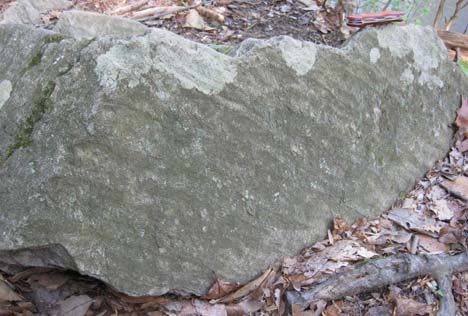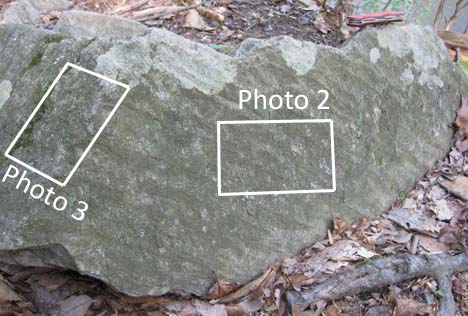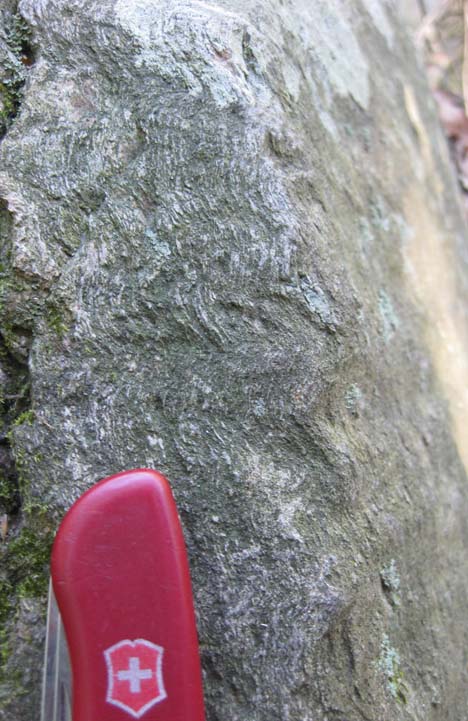15 April 2010
Crenulation lineation
Posted by Callan Bentley
Hiking last Sunday in Rock Creek Park, DC, I saw this boulder and my eye was immediately drawn to the linear pattern running from upper left towards lower right (Swiss Army knife at upper right for scale):
Because that photo is not especially large, let’s zoom in a bit to two sections… Here is Photo 1, annotated to show the areas we will look at next:
Here’s a cropped and higher-resolution look at the diagonal lineations that caught my eye:
There are lots of different linear elements that can show up in rock fabric (as distinguished from the many kinds of planar elements that could be found). Some lineations are primary, but the ones that interest me are secondary (i.e., tectonic in origin). Let’s rotate our perspective, moving to the left of the first photo, and turning our head ~70° to look towards the right. This closer look at the left face of the boulder reveals the origin of these particular linear elements:
…They are crenulation lineations, essentially very small folds that deform the cleavage of these highly-foliated rocks. The crenulations’ fold axes were popping out in very slight 3D relief on the face of the boulder that initially caught my eye, like tectonic “ripple marks.” On the right side of Photo 3, you can see the lineations (fold axes) stretching away into the blurry distance.
In addition, some of the convex-outward crenulations had been breached, which means that the trace of the foliation was outcropping along the same trend as the fold axis. This is a variety of intersection lineation: two planar elements intersecting in a line. In this case the planar elements are [a] the foliation and [b] the outcrop surface.
(The other, more “classic” variety of lineation is a mineral stretching lineation, like the lineated gneiss I showcased last November.)
So, how should we interpret these rocks? I’d say that an initial foliation was imparted to them due to shearing along the Rock Creek Shear Zone, a prominent north-south-trending zone of smeared rocks in northwest DC; about 1 km wide. The foliation formed perpendicular to an original σ1 maximum principal stress direction. Later, the stress field changed, and deformed this pre-existing foliation. The new σ1 was oriented (using Photo 1 as our reference) from the lower left towards the upper right. The new σ2 was oriented parallel to the crenulation fold axes (upper left towards lower right). And the new σ3 was oriented in the direction perpendicular to the main outcrop face — that’s why the folds pooched out in that direction. (It offered the least resistance to being pushed.)
Recall that we saw something similar in the snow back in February.
Anyhow, I had just gotten through discussing lineations with my GMU structure students, so I figured I should photograph this particular outcrop for their benefit…
…and, I suppose, for your benefit as well, dear blog reader.






 Callan Bentley is Associate Professor of Geology at Piedmont Virginia Community College in Charlottesville, Virginia. He is a Fellow of the Geological Society of America. For his work on this blog, the National Association of Geoscience Teachers recognized him with the James Shea Award. He has also won the Outstanding Faculty Award from the State Council on Higher Education in Virginia, and the Biggs Award for Excellence in Geoscience Teaching from the Geoscience Education Division of the Geological Society of America. In previous years, Callan served as a contributing editor at EARTH magazine, President of the Geological Society of Washington and President the Geo2YC division of NAGT.
Callan Bentley is Associate Professor of Geology at Piedmont Virginia Community College in Charlottesville, Virginia. He is a Fellow of the Geological Society of America. For his work on this blog, the National Association of Geoscience Teachers recognized him with the James Shea Award. He has also won the Outstanding Faculty Award from the State Council on Higher Education in Virginia, and the Biggs Award for Excellence in Geoscience Teaching from the Geoscience Education Division of the Geological Society of America. In previous years, Callan served as a contributing editor at EARTH magazine, President of the Geological Society of Washington and President the Geo2YC division of NAGT.